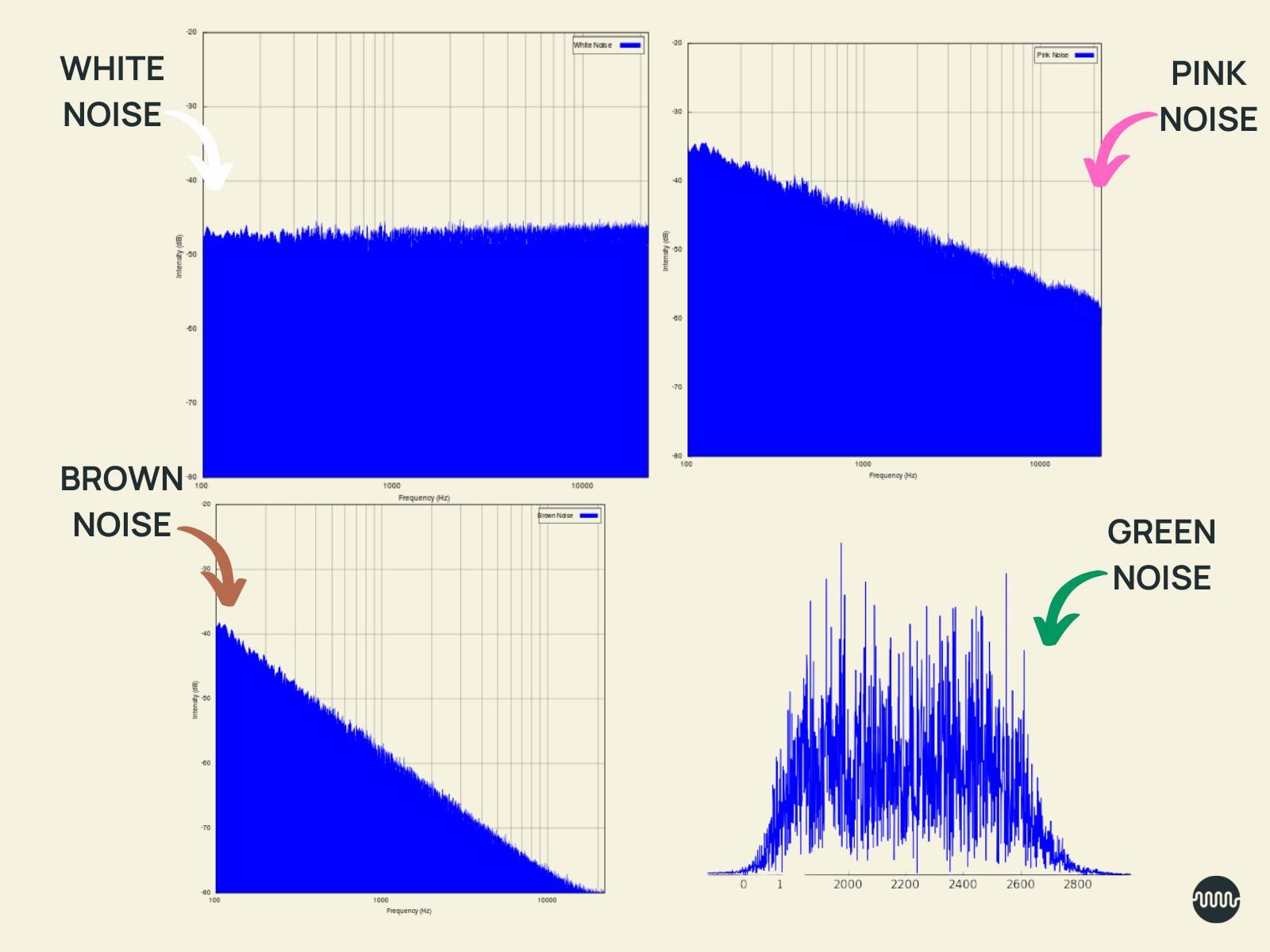Key Takeaways:
- White, brown, pink, and green noise each have different sound characteristics.
- White noise is an equal distribution across all sounds. While other colored noise is a filtered version of white noise (e.g., brown emphasizes low frequencies).
- While research is still growing when it comes to colored noise, brown may help with concentration, pink helps with sleep, green helps with calming, and white noise is especially good at drowning out noise from neighbors.
.png)
As an audiologist, I have always been interested in the science behind sound. One especially fascinating aspect of sound is the difference between sound colors. White noise is well-known but pink, brown and green noise are on the rise via smartphone apps and Spotify playlists.
People use sound masking to manage tinnitus, soothe babies (or pets) and get stress relief.
In this article, we will explore the colors of noise, and their benefits.
Let's get into it!
The Differences Between White, Brown, Pink and Green Noise
Each color plays sounds in a different location on a frequency spectrum. The frequency spectrum measures frequency and volume. Here's what each color looks like through a sound engineer's tools.

What do sound colors mean in real world terms?
When you play white, brown, pink or green noise you'll hear a distinctly different tone that may bring water, plane travel or the womb to mind. Each sound color has unique benefits (more on that below).
.jpg)
Here's a brief summary of how these types of noise differ from one another:
White noise - an equal distribution of all frequencies across the spectrum (example: TV static)
Brown noise - filtered white noise that creates an emphasis on low frequencies (example: thunder, heavy rain)
Pink noise - filtered noise in between white and brown noise (example: light rain falling, leaves rustling)
Green noise - filtered white noise, centered around 500 Hz (example: an ocean or stream)
.jpg)
Benefits Of Each Sound
Each sound color has distinct auditory profile and a unique set of health and wellness benefits.
White Noise For Blocking Out Neighbors
White noise is an effective ambient noise option for blocking out unwanted environmental sounds. This static-like sound drowns out loud neighbors, barking dogs, or bustling traffic noises. This acoustic phenomenon covers the entire range of audible frequencies, masking disruptive sounds that interfere with concentration or relaxation.
The consistent and unchanging nature of white noise can create a privacy screen, helping to establish a quieter, more serene environment conducive to focus, relaxation, or sleep. Studies even suggest that white noise can enhance productivity, making it easier to tune out other noise in the office and an excellent tool for workplaces and study spaces.
Brown Noise Benefits For Concentration
In a study on brown noise's effects on cognitive performance, it was shown to enhance executive functioning by improving working memory. The participants who listened to brown noise during sleep outperformed those who worked in silence or other types of noise.
Brown noise contains less high-frequency sound energy than other colors of noise, and the result can be an effect of neurons firing in the hypothalamus to promote quicker access to information flowing from the hypothalamus to the cerebral cortex. For this reason, brown noise can aid concentration or focus. Therefore, brown noise can help increase engagement, improve creativity, and reduce stress.
Pink Noise for Restorative Sleep
Pink noise is an intriguing sound that corresponds well with the signals associated with various mental activities. The frequency spectrum of pink noise aligns to stimulate the brain's neural rhythms, promoting an environment conducive to cognitive processing.
Notably, pink noise has been linked to improved memory and sleep quality, particularly in older adults. A study was conducted wherein participants were exposed to pink noise during sleep. The study found that the individuals who listened to pink noise enhanced their memory recall abilities compared to those who slept without any noise. Furthermore, these participants reported a significant improvement in their sleep quality. This suggests that pink noise may support memory function and play a crucial role in fostering restorative sleep.
Green Noise for Calmness
Green noise is a relatively new concept and is not as popular as white, pink, and brown noise. This one is a bit mysterious because there isn't a ton of research on it yet. But some people find green noise very soothing, almost like the sound of a stream or water flowing. It's filtered around 500 Hz, right in the middle of the frequency spectrum.
Maybe it reminds us of our early days in the womb? A study from the NIH on fetal hearing in the womb found that at around 19 weeks of age, babies can start hearing in the womb, and they showed responses to sounds at around the 500 Hz range. As green noise is filtered white noise centered at around 500 Hz, we may subconsciously tap into those early, soothing memories of our first sounds in the womb. I think of it a bit like those compression blankets that help soothe our nervous system, reminding us of our early days in the womb. It brings a sense of calmness, reduces muscle tension, lowers heart rate, and enhances mood.
Which type of noise is best for tinnitus?
In my experience, the right type of noise to best mask tinnitus is highly individual. Just as every person perceives tinnitus differently, for some, it is a low roaring. In contrast, for others, it sounds like high-pitched ringing or cicadas, the type of noise needed to mask this sound will vary depending on the tinnitus perception. One study found that customized, notched noise was particularly effective at providing relief for a sample group.
I've also seen this in clinic, with some patients responding best to a customized masking program in their hearing aids that targets the specific frequency region of their tinnitus. Another study evaluated different colors of noise with tinnitus patients. Some found the more pronounced high-frequency sounds in white noise to exacerbate their tinnitus percept and thus preferred the "softer" sound of brown noise (red noise). Ultimately, you'll be the best judge of the sounds most helpful for you. I'd encourage you to try the ReSound Relief app if you'd like to create your own soothing soundtrack.
If you’re looking for more suggestions to help manage tinnitus, take a look at these tips.
Final Thoughts
In conclusion, colored noise can be beneficial to individuals in various ways. White, pink, and brown noise are the most commonly used noise types, while green noise is increasing in popularity. White noise can improve sleep quality, suppress background noise, and increase relaxation. Pink noise promotes relaxation, enhances memory, and stimulates growth hormone production.
Brown noise helps increase concentration, improve creativity, and reduce stress. Finally, green noise is perfect for relaxation. Incorporating colored noise into your daily routine can help you optimize your performance, enhance your concentration, and improve your mental and emotional well-being.






